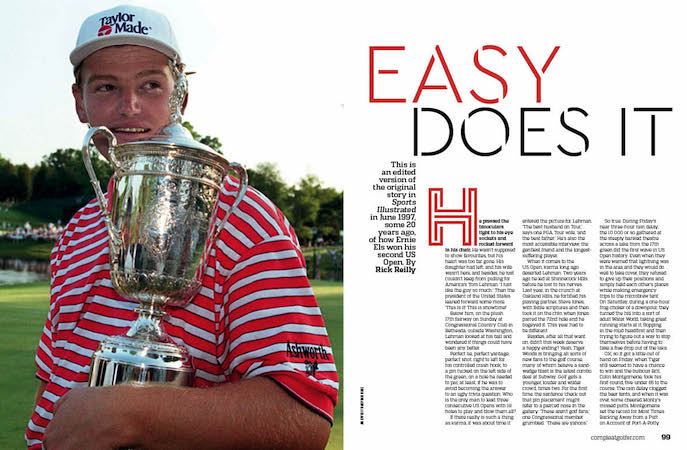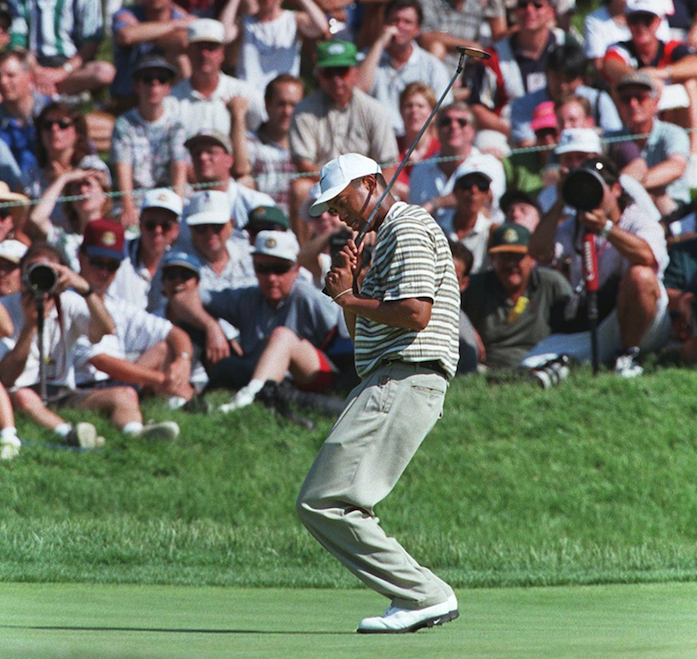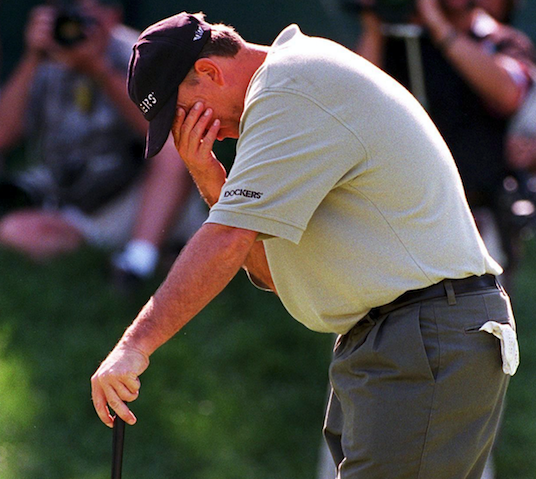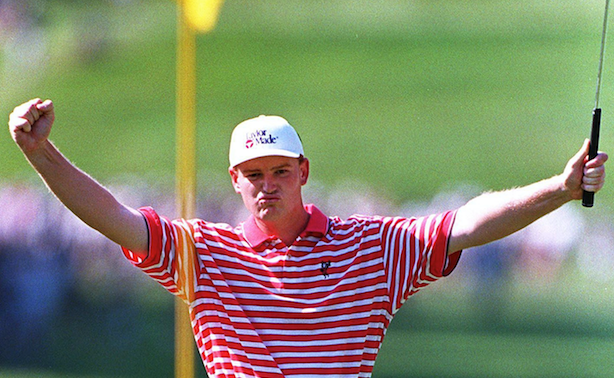He pressed the binoculars tight to his eye sockets and rocked forward in his chair. He wasn’t supposed to show favourites, but his heart was too far gone. His daughter had left, and his wife wasn’t here, and besides, he just couldn’t keep from pulling for America’s Tom Lehman. ‘I just like the guy so much.’ Then the president of the United States leaned forward some more. ‘This is it! This is showtime!’
Below him, on the plush 17th fairway on Sunday at Congressional Country Club in Bethesda, outside Washington, Lehman looked at his ball and wondered if things could have been any better.
Perfect lie, perfect yardage, perfect shot, right to left for his controlled crash hook, to a pin tucked on the left side of the green, on a hole he needed to par, at least, if he was to avoid becoming the answer to an ugly trivia question: Who is the only man to lead three consecutive US Opens with 18 holes to play and blow them all?
If there really is such a thing as karma, it was about time it entered the picture for Lehman. ‘The best husband on Tour,’ says one PGA Tour wife, ‘and the best father.’ He’s also the most accessible interview, the gentlest friend and the longest-suffering player.
When it comes to the US Open, karma long ago deserted Lehman. He led at Shinnecock Hills before he lost to his nerves. In the crunch at Oakland Hills, he fortified his playing partner, Steve Jones, with Bible scriptures and then took it on the chin when Jones parred the 72nd hole and he bogeyed it. 1997 had to be different.
Besides, after all that went on, didn’t that week deserve a happy ending? Yeah, Tiger Woods was bringing all sorts of new fans to the golf course, many of whom believed a sand-wedge blast was the latest combo deal at Subway. Golf was getting a younger, louder and wilder crowd, times two. For the first time, the sentence ‘check out that pin placement’ might have referred to a pierced nose in the gallery. ‘These aren’t golf fans,’ one Congressional member grumbled. ‘These are yahoos.’
So true. During Friday’s near three-hour rain delay, the 10 000 or so gathered at the steeply banked theatre across a lake from the 17th green did the first wave in US Open history. Even when they were warned that lightning was in the area and they would do well to take cover, they refused to give up their positions and simply held each other’s places while making emergency trips to the microbrew tent.
On Saturday, during a one-hour frog-choker of a downpour, they turned the hill into a sort of adult Water World, taking great running starts at it, flopping in the mud headfirst and then trying to figure out a way to stop themselves before having to take a free drop out of the lake.
OK, so it got a little out of hand on Friday, when Tiger still seemed to have a chance to win and the bulbous Brit, Colin Montgomerie, took his first-round, five-under 65 to the course. The rain delay clogged the beer tents, and when it was over, some cheered Monty’s missed putts. Montgomerie set the record for Most Times Backing Away from a Putt on Account of Port-A-Potty Doors Slamming. All of which accompanied his 76.
God forbid Woods would’ve been in the hunt or the spectators might have turned Congressional into a Manchester United game.
There was talk that Tiger, coming off his historic Masters win, might even make a run at the Grand Slam. Instead, he started his week by shooting a four-over 74, blowing past 100 reporters who were looking for a comment and storming to his courtesy car, where he took his portable CD player and did the Sony Slam into the floorboard. ‘Why would you want to talk to a guy who is nine shots out of the lead?’ Woods explained the next day. Why? For the same reason people wore full-wool tiger suits in the heat and NBC kept going to breathless live coverage of Woods warming up on the practice tee. ‘Johnny, I think he’s going to – yes! He’s aiming for the range tractor!’
He finished 19th at six-over 286. ‘I’m humbled,’ he said. At least he completed all four rounds, something that cannot be said of John Daly. For the umpteenth time Daly quit on his fans, this time somewhere between the 9th green and the 10th tee. Daly, only three weeks out of the Betty Ford Clinic, putted out on the 9th hole (at 10 over par and in danger of missing the cut) and disappeared.
Playing partners Ernie Els and Payne Stewart teed off on the 10th, then turned to find no Daly. Not even Daly’s caddie, Brian (Wedgie) Alexander, a guy not much bigger than the bag he was toting, knew his boss’ whereabouts. They waited.
Daly didn’t show. They waited some more. Daly didn’t show. A USGA official went looking for him. Daly didn’t show. Finally, Els and Stewart went on, leaving Wedgie waiting by himself. When he was finally found, Daly was having a cigarette in his courtesy car. Then he started the car and drove straight through to his home in Memphis – some 850 miles away.
One player who wouldn’t go away, was Montgomerie. He played well in the gloaming on Saturday, pulling to within two shots of the lead. For his part Lehman looked like a man who had forgotten his glasses. ‘We don’t even like Tom to drive at night,’ said his father, Jim.
‘I have terrible night vision,’ Tom said. ‘I never saw one of my shots land.’ It cost him dearly. He bogeyed two of his last four holes before play was suspended by darkness.
Els, meanwhile, was doing the kind of thing that wins Opens – loitering. By Saturday night, the South African was hanging around at even par, and on Sunday he got his 5am wake-up call, went out with Lehman and Texan Jeff Maggert, and wrote himself an invitation to the chase, finishing his third round with three birdies in five holes.
Els is one of those guys who like to make sure they are caught up on their foot-dangling, the sort who likes nothing more than to sit silently with a friend for 10 minutes with his hat tipped over his face, then say, ‘Isn’t this great?’ He likes his lager and is likely to be found drinking it with a bunch of caddies.
In fact, he is more often going to bed at five in the morning than getting up at that hour. ‘Ernie is so laid-back it’s frightening,’ Montgomerie says.
Lehman started Sunday at seven, playing ‘the five best holes I’ve played all week’ – two birdies and three pars. The strong finish moved him to five under par at the end of three rounds, good enough for a two-shot lead over Els and Maggert. Montgomerie was another shot back.
But by the time Lehman returned for his mid-afternoon tee time, he had cooled. And as the quartet of contenders made the turn, Lehman, Maggert and Montgomerie were tied at four under, a shot ahead of Els, who soon joined the first-place deadlock with a monster chip for birdie at the difficult par-four 10th. They were in the last two pairings, and they were playing some of the most thrilling golf in US Open history. ‘It seemed like the game was on,’ Lehman said, so he dug in. He hit killer approach shots at 10 and 11, only to miss birdie putts from eight and four feet.
Els took the lead with a birdie at the 12th, then coughed it up on the next hole. After missing birdie putts from close range at 11 and 12, Maggert dropped out with a three-putt bogey on 13, and Lehman looked ready to join him after he bogeyed the 14th, only to come clawing back to birdie the 15th. Three were tied again.
In the group ahead, Monty was making pars by flushing his 3-wood down the gut of the string-bean fairways and Els was one-putting half of Maryland. In one stretch he one-putted 10 of 13 holes.
On the 16th, Lehman missed the green by mere feet, but followed with what seemed like a perfect greenside chip. ‘Stop, stop, stop!’ President Clinton yelled at the TV set from his box at the 17th, but golf balls are not generally under executive branch jurisdiction, and this one refused. Bogey. Els and Monty led by one.
Then Lehman came to the most dangerous hole on the course, the water-logged, 480-yard, par-four 17th, and thumped his best drive of the day. Minutes before, the gum-chewing, slow-moving, happy-go-lucky Els had put his slowest and sweetest swing of the day on an unforgettable 5-iron that flagged the pin and stopped eight feet behind it. ‘In all my life,’ Els confessed later, ‘I’ve never felt such tension.’
He missed the putt and marked. Then Monty took more than five minutes to hit his five-foot try for par. The Scot, who seems to have remarkable hearing, said there was a disturbance to the left of the 17th and he was unsure what was happening across the water on the 18th green, so he waited. All that dallying ‘got to me a little bit,’ said Els. ‘And you know, he missed his putt. I just went up and knocked mine in.’
Now, with the crowd and a country and a president behind him, Lehman lined up that 7-iron at 17. Of the three contenders left, Lehman was the only American. Of the three left, Lehman was the one with the most kids (three). Wasn’t it Father’s Day? Of the three left, Lehman was the oldest, at 38. ‘You just don’t get many chances like this,’ he admitted afterwards.
Against all odds, the toe of that perfect 7-iron caught in the ground as he swung, and the ball drifted left, landing on the bank of the green and dribbling into the water with a glug. ‘I’d give anything in the world for a mulligan,’ Lehman said.
After taking a drop, Lehman still could have salvaged a par by holing his chip shot. No such luck. Two shots back as he stood on the 18th tee, could this be what the gods had saved up? An ace to force an Open playoff? The 7-iron landed eight feet beyond the cup. ‘It’s hard enough to make a hole-in-one,’ Lehman said. ‘Much less on the 72nd hole of the US Open.’
Montgomerie, meanwhile, had needed only a birdie to force a playoff. His 25-foot putt drifted left. Afterwards, Monty wandered toward a roped-off section of the Congressional verandah and cried.
For Els, it was the sweetest victory of his life. His buttery swing, trusty stroke and deep vats of patience never left him. ‘When I won the US Open in ’94, I said if people would be patient with me, I’d win another of these,’ he said. ‘And I have.’
Like Jack Nicklaus, he won his second Open at age 27, and he might just come ambling along and pick up another every three years or so. For his latest effort, Els received a $465 000 cheque and God knows what kind of endorsements. ‘I wasn’t ready the first time I won the US Open,’ he said. ‘I’m ready now.’
Said Clinton of the 6ft 3in Els, ‘Big, strong kid, isn’t he? Looks like a linebacker.’
*This is an edited version of the original story in Sports Illustrated in June 1997, some 20 years ago, of how Ernie Els won his second US Open by Rick Reilly.
– This article first appeared in the June issue of Compleat Golfer, now on sale











